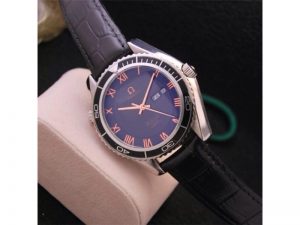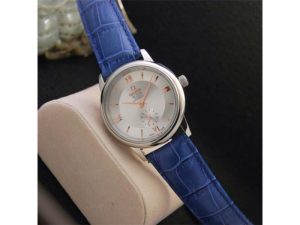
The cheap Omega watch famous as the Alaska Project was initially developed as one of several efforts made by Omega to introduce a version of the Speedmaster built specifically with support for manned space flight in mind. As we all know, the original Speedmaster was never made for use in space, and especially not for one of the roles in which it became most famous: as a fake watch to be worn during EVA (that is, on the outside of a suit during a spacewalk, or during work on the lunar surface). “Alaska” had no relationship with the state of Alaska; instead, it was simply replica Omega’s internal code-name for the project, which included a version of the Speedmaster with a very large, cushion shaped titanium case.
However, the most famous version of the Alaska Project Speedmasters is one that was tested by NASA in 1972. This version had a zinc coated dial, high visibility hands for the minute and hour registers, and most conspicuously, a very large red anodized aluminum outer shroud, designed to protect the fake watch from excess heat. 
It was long thought that these replica watches were never actually used in manned space flight and as far as we know, this is completely true of the US space program; apparently, NASA never took the project beyond the prototyping stage, and never tested the Alaska Project watches in a spacecraft, or during EVAs. However, the Omega-focused Tumblr known as Moonwatchuniverse, has run across what seems incontrovertible photographic evidence that in fact, at least two Alaska Project cheap replica watches were used: on Soyuz 25, which in 1977 became the first Soviet spacecraft to attempt to dock with the newest Soviet space station, Salyut 6. Though little remembered today, Salyut 6 was revolutionary for its time and orbited the Earth from late 1977 through July 1982, when it was de-orbited and as planned, burned up during reentry into the Earth’s atmosphere. 
Salyut 6 was released unmanned, and the first manned attempt to dock with it was Soyuz 25, with two cosmonauts named Vladimir Kovalyonok and Valery Ryumin as crew. Unfortunately they failed to dock with Salyut 6 despite 5 attempts and had to return to Earth after two days – neither had any prior piloting experience and this resulted in a new regulation in the Soviet space program, that any manned mission must have one crew member at least who had been in space at least once before. For our purposes, however, the main point of interest is a photo posted on Moonwatchuniverse, which shows Kovalyonok and Ryumin wearing what appear to be Alaska Project Speedmasters on their flight suits, as they walked to their launch vehicle.